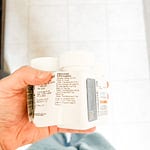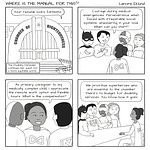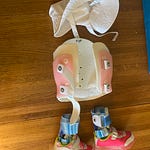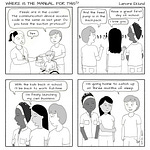“Families have no choice, often, but to call the cops on their own kids” — Abigail Kramer, reporter for The City
TW: This issue refers to youth suicide. Call 9-8-8 for immediate assistance in a crisis.
When journalist Abigail Kramer first started talking to families and mental health professionals in New York, it took a long time to figure out what the story was. The youth mental health crisis was clear — but complex and overwhelming. Kramer said she found “a near-universal sense of outrage” from her sources and quickly determined that everyone was angry with the state government.
Even so: “It took me a long time to land on a cohesive story for reporting,” she said during a webinar I attended this week from the USC Annenberg Center for Health Journalism.
Kramer’s reporting would eventually focus on data sets showing that a plan to move pediatric mental health patients to community-based settings only succeeded in eliminating beds in hospitals and institutions. Their replacements never materialized. That left desperate families in crisis with nowhere to turn. The series was published this year in partnership with ProPublica and has already spurred New York Attorney General Letitia James to investigate what appear to be violations in the right to services.
Unfortunately, the lack of adequate pediatric mental health resources is not a problem unique to New York state. The youth mental health crisis is nationwide and particularly acute in my home state of Oregon, which ranks last or one of the worst in several indicators of youth mental health tracked by nonprofit Mental Health America. (See their 2022 report.)
Read more: Mama, it's not you. Oregon's youth mental health services really are in free-fall
The worst can happen. Youth suicide is real. Children — even young children — really do kill themselves. In fact, the Centers for Disease Control and Prevention says suicide is the second-leading cause of death among children ages 10 to 14.
Another of the panelists, New York University professor Dr. Michael Lindsey, said that in 2019, there were 3,703 suicide attempts per day among high school students. The period from 2019 to 2020 saw a 31 percent increase in youth showing up at emergency rooms with some sort of self-harm behavior or other mental health crisis.
But there are reasons to hope, resources and solutions.
Meadows Mental Health Policy Institute Executive Vice President Dr. Julie Kaplow is part of the team that is helping to rebuild after the May 24 mass shooting at an elementary school in Uvalde, Texas. She spoke about the program her team is using to help the community process through trauma.
“What we know is that society’s most significant problems — including … domestic violence, community violence, mass shootings — stem from unresolved childhood trauma,” Kaplow said, noting that the police visited the Uvalde shooter’s house eight times before the tragedy. “The more we can intervene early … the more we can prevent these kinds of tragedies going forward.”
In addition to the evidence-based and modular Trauma and Grief Component Therapy*, she explained how the Handle With Care program was improving communication and awareness between law enforcement and schools. The idea is simple: when a child is present at a traumatic scene, law enforcement or child protective services acts with compassion and then notifies the school so that they, too, can watch for worrisome behavior.
With an estimated 250,000 children losing a caregiver to COVID-19 in the last two years, Kaplow says there needs to be a particular focus on healthy bereavement and grief. The death of a loved one is not only the most common form of trauma, it is also the most strongly associated with poor academic outcomes, she said.
Read more: How to smile again: Grief and motherhood
So what is trauma?
Kaplow defines it as “the experience of real or perceived threat to life or bodily integrity.” That perception can be key, especially during emotional teen years when so much is riding on social interactions.
Lindsey, from the NYU Silver School of Social Work, explained his research finding that 15-17 year-olds were more likely than others to have their suicide deaths associated with a “relationship challenge.”
Suicide has increased dramatically in recent years among Black youth. Lindsey’s research found a 144 percent increase in the number of Black youth committing suicide in 1991 versus 2019, a period during which white youth suicide rates decreased slightly.
“This led us to try to figure out why there might be an increase particularly among Black youth,” Lindsey said. He listed cultural barriers like messages to “man up” or “handle problems within the family.” But he also said distrust of service providers may be warranted.
When traumatized kids act out, “school personnel are not asking kids about what is underlying that anger,” Lindsey said. “The tendency is to suspend those kids or expel them from school.”
Anger is often preceded by feeling a lack of control. It wouldn’t surprise me if children from social minorities felt that way more often, because they, in fact, have less control.
I certainly felt anger when Lindsey pointed out his next statistic: that behavior infractions at school correlate to the time of the month when money runs out and food or other resources are more scarce. Children getting punished for being hungry.
Lindsey believes that more social-emotional curriculum throughout K12 schools, as well as enough mental health counselors for students, would stem the tide.
Kaplow agrees that talking through trauma is the best way to process it.
“We somehow have adults concerned that if they bring it up they will upset the child more,” she said. “But what we find is that the more we can talk about it openly — the more we can directly address it head on — the better the outcome for the child.”
As for how to change the system for good, The City reporter Kramer said she soon learned where to look for the people who could explain the issues the best.
“I found that parents who had sort of become advocates for their own kids and then become helpers to other families were: A. absolutely the best people to help me understand how the system works and how you actually navigate it and B. … that, once I earned that trust, people were very willing to make connections and were incredibly generous with their time, and their experiences, in talking to me.”
If you are raising one of the 2/3 of young people who have experienced something traumatic in their lives, please check out these resources for caregivers: https://mmhpi.org/work/trauma-grief-center/virtual-learning-library/
*When you purchase via links on my site, I may earn a commission.
Medical Motherhood’s news round up
Snippets of news and opinion from outlets around the world. Click the links for the full story.
• From The Statesman Journal: “Parents paid as caregivers for kids with disabilities may lose funds”
Hunter Tennison-Hayes, 10, was diagnosed with autism when he was 3. He also has a form of epilepsy.
His parents, Kellie Hayes and Michael Tennison, struggled to balance caring for Hunter with work and finishing college. They said it was impossible to find caregivers — even after qualifying for a state program that paid for them. They relied on help from friends and roommates before Kellie dropped out of school to focus on caring for Hunter full-time herself.
Then, during the COVID-19 pandemic, the state created an emergency rule to allow some parents to get state funding to care for their own children. Kellie was able to enroll and now receives income to care for Hunter.
But they could soon lose that money.
The emergency rule is set to end as soon as the federal government declares an end to the COVID-19 public health emergency. Hayes and other parents of disabled children are working to make the change permanent, but it's become a race against time.
They're also facing opposition from groups that are usually their biggest supporters. Some disability rights groups argue that the rule was meant to be temporary and that parents should stick to being parents.
The Oregon K Plan, a Medicaid plan adopted by the state, provides federal and state funding forprimary care to people with intellectual and developmental disabilities. People receiving services under the K-Plan go through a functional needs assessment to determine the disability support services they are eligible for.
Full disclosure: I’m friends with Kellie Hayes and we work on this campaign together. For Medical Motherhood coverage on this issue, please see this list.
• From Oregon Capital Chronicle via The Lund Report: “OSU Study Calls For Better Screening Of Sexual Abuse In Children”
A recent study by researchers at Oregon State University found that chronic childhood sexual abuse is more likely to lead to negative outcomes in adults than single instances of trauma.
The findings highlight the importance of screening for chronic trauma, rather than relying on one-time checklist-style assessments, which, for instance, ask how severe was the abuse or who was the abuser to the victim.
Popular assessment tools like the Adverse Childhood Experiences, which consists of a series of questions, could be greatly improved with a few basic follow-up questions about the duration of abuse, according to the study’s lead author, Ashley Schuyler.
“(Adverse Childhood Experiences) is useful, but maybe not the most helpful in identifying the individuals who need the most help.” Schuyler told the Capital Chronicle.
Along with physical and mental health challenges, adults who experienced chronic abuse as children suffer from higher rates of drug abuse, poverty and incarceration. Longer durations of childhood trauma are also linked to higher rates of emotional and physical health problems, sexual dissatisfaction and dysfunction, relationship and marital problems, fair or poor overall health, lower educational attainment, income below the poverty level and a history of incarceration.
• From Stanford University: “The BUDI system: Stanford medical student Blynn Shideler designed a wearable device to make daily physical therapy more accessible for kids with cerebral palsy.”
Medical student Blynn Shideler arrived at Stanford with an award-winning health device – and every intention of improving it.
The device addresses a need in the cerebral palsy community. Often, kids with cerebral palsy – a group of disorders that affect movement, balance, and posture – need daily sessions with a physical therapist to build strength and improve motor skills. As an undergraduate studying bioengineering at Columbia University, Shideler thought there must be a better way.
He collaborated with other students to design a device that would make it easier for these kids to perform their therapy exercises at home, or anywhere. The result was BUDI – the Biofeedback Upper-limb Device for Impairment – a bulky bracelet built with sensors that tracked motion and provided feedback on how the user might want to adjust how they are moving.
[…]“I learned about building an iOS app and what you can do with the available sensors on Apple watches and iPhones,” he said. “It really started to click; maybe BUDI could be designed as software on a commercially-available smartwatch rather than building bracelets and shipping them to people.”
If BUDI were available in the app store, Shideler thought, kids anywhere could have physical therapy on demand on their wrists. It would give them some autonomy, help alleviate problems created by a shortage in physical therapists, and reduce the strain on families who currently take their kids to therapy every day.
Medical Motherhood is a weekly newsletter giving those raising disabled children the news and information they need to navigate complex systems. Get it delivered to your inbox each Sunday morning or give a gift subscription. Subscriptions are free, with optional tiers of support. Thank you to our paid subscribers!
Follow Medical Motherhood on Facebook, Twitter, TikTok, Spotify, Apple Podcasts, or Instagram or, visit the Medical Motherhood merchandise store to get a T-shirt or mug proclaiming your status as a “medical mama” or “medical papa.”
Do you have a question about raising disabled kids that no one seems to be able to answer? Ask me and it may become a future issue.
















Share this post